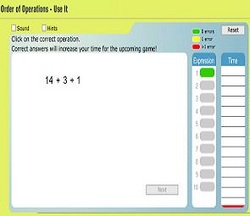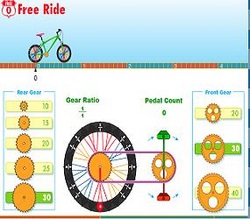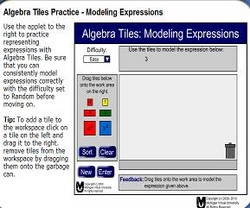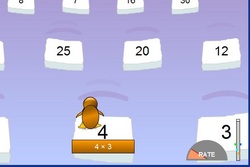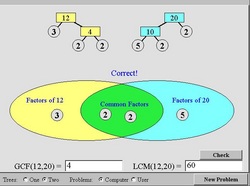According the Principles and Standards for School Mathematics, students at the 8th grade level should be able to understand and apply the relationships between numbers, number systems, and operations within those systems. This application of numbers will include all forms of rational numbers and proportional relationships between numbers.
Order of Operations
Although students begin learning the order of operations in earlier grades, many students in the middle school grades have difficulty putting the rules together and cementing correct order and process for themselves, especially as numbers begin transitioning into variables and more complicated expressions. By giving instant feedback throughout each problem, students are able to learn to follow the correct order at their own pace and without the fear of failure. Students learn a quick ability to make judgments about what to do next as they go through a problem. This learning takes place by giving students problems with various difficulty levels and step by step problem solving. By giving feedback on every step, students learn to decipher their next move based on what they did previously to simplify the expression. The technology involved in this process is intended to help students make decisions without feeling defeated if they do an entire problem and check the answer only to have the problem wrong. With traditional methods and without use of this technology, students would have no idea where exactly they went wrong. Also, by having the site do all the actual computations according to what the student selects for the next operation to follow, the task’s goals become more focused; teachers can watch students work and see whether or not they are meeting the standard of following order of operations without having to assess basic math fact knowledge at the same time. This assists in the eighth grade curriculum by allowing students to assess their selves on just this one concept until it is mastered.
Free Ride
Students can use this activity to develop a better understanding of ratios through a very familiar exercise: riding a bike. Students are learning the connection between placing certain numbers with like factors in a fraction, or ratio, and applying that ratio to the turn of the bike wheel. Because fractions are being applied we know that division is as well, though even the whole number results are left as fraction in the ratio image. Students do come to see how the ratio is actually the result of any fraction when it is reduced, which applies the principle of division, as it is required to divide out the common factors between the two numbers in the fraction and result in the ratio to be applied in the problem. The majority of the activity is focused on an instrumental process involved in choosing gears that create a ratio that appears to be twice the distance you want to travel (as you will pedal the bike one half time each time). They should also discover multiple ways that they can create the same ratios using different combinations of gears. The dynamic aspect to this activity is one that can only be achieved to this extent by using the technology involved. Similar explorations might be created otherwise, but the involvement of technology is to give students instant access to multiple "routes" (levels) and feedback that is instant in the form of watching the bike either reach the desired destination or not is undeniable. Students are encouraged to understand how numbers, when placed with other numbers in a fraction, reduce to create a ratio in simplest form that can be used to predict distance of movement. The effect of the ratio on the distance that the pedal turn will result in is the connection to division and reduced ratios. Because of this, the activity fits well as a concept-building activity for ratios and proportions at this level.
Modeling Expressions
In this applet created by Michigan Virtual University, students are learning to use algebra tiles to model algebraic expressions. Once an expression is correctly modeling using tiles valued at 1, x, x2, and their opposites, students work on combining like terms and creating zero pairs to simplify the expression. There are directions and examples at the start of the activity that allow students to understand how algebra tiles work if they have never used them before, though it is likely that many students will have used at least physical tiles in earlier grades. Learning takes place through practice and a forced step-by-step pattern or recognizing what needs to be done next to create the desired expression and reduce it to its simplest form. The benefit of using the technology rather than actual tiles for this skill is that students can manipulate what they are doing faster than by hand and are actually prevented from continuing the work if they have completed each step correctly. Eighth grade curriculum demands that students hone in on recognizing when expressions and answers have been simplified for easier representation of solutions. This skill is extremely important when students continue in their pre-Algebra skills and solve single and multi-variable equations.
Penguin Jump
The activity doesn’t so much teach students anything new, but would be an entertaining and fun way for students to practice a skill that all eighth grade students should be proficient in yet sadly are not. The game allows students to play with up to four students, meaning they can actually compete against one another within the room. This skill in this game in particular is multiplication facts, although the main site has several other skills that can be practiced. The technology employs the flash player to work and provides an endless number of problems along with instant feedback about the student’s progress for that student. Although multiplication is below the eighth grade level, I can see how a resource such as this would be fun to use for a practice day or break time for students who really do need the motivation, time, and direction to practice their facts. This kind of game could also be used as a reward for students who are completing other dynamic work online and are waiting for others to finish. It isn’t something they need much help with to get started but it would keep them very focused on a skill that is always good to practice improving recall skills with at this age.
Factor Tree
This applet combines several key number sense ideas into one activity. Students first practice finding factors of two numbers, which is an idea that is important for many areas of algebra. Once students have finished factoring both numbers, a Venn diagram is used to compare those factors which are factors for only one of the numbers as well as those which are for both. If students correctly do this, they are then able to use the Venn diagram to find the GCF and the LCM. The learning in this activity is very step by step and logical for students to follow. The technology provides the focus and organization of the student’s thought process, as well as provides feedback for the student’s work. This type of activity would fit within the curriculum as students are reviewing working with fractions and with factoring polynomials. Even though the second of these won’t come until Algebra I, students will have to do the former (working with fractions) all throughout their eighth grade math class.
